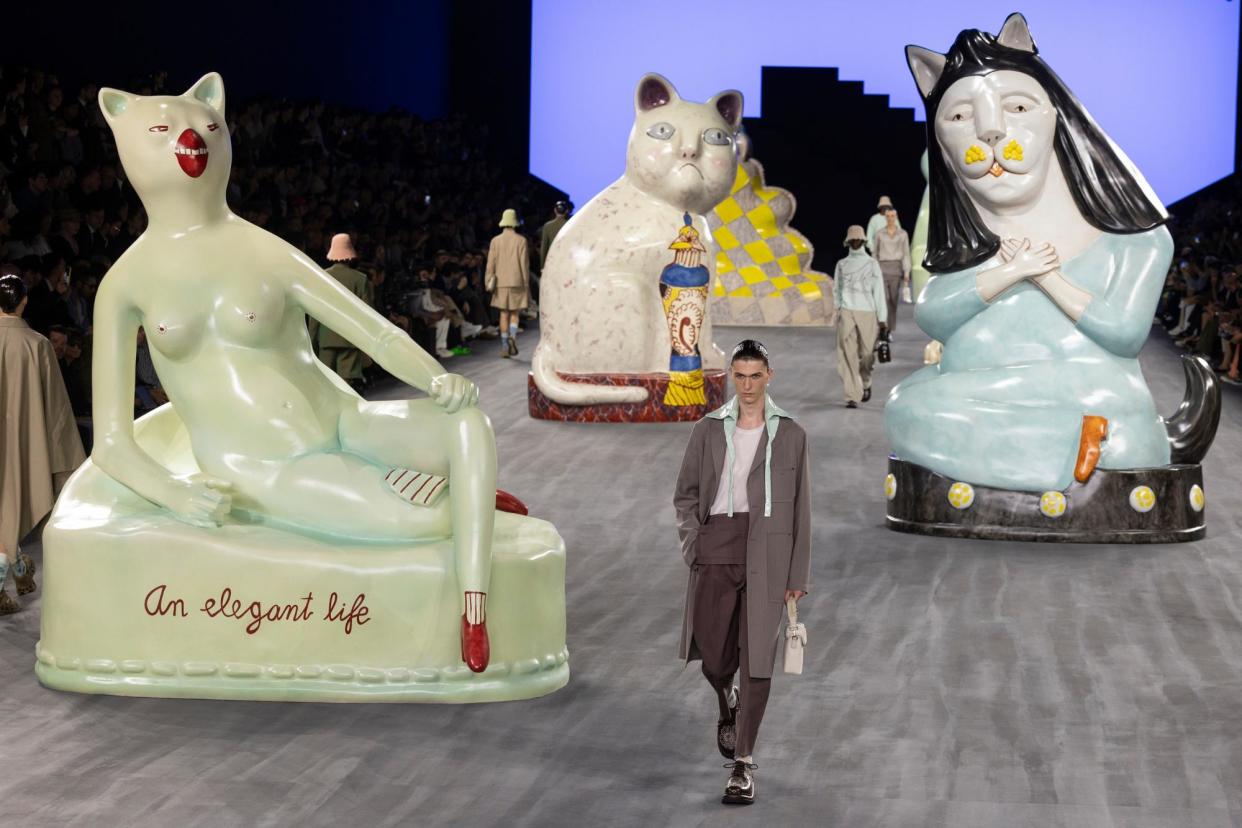Kim Jones opts for ceramic cats and classics at Dior Paris menswear show

The Dior menswear designer Kim Jones has gained a reputation as a somewhat prolific collector of art and rare books. His homes are peppered with pieces by Francis Bacon and Andy Warhol, and he is the owner of the largest collection of Virgina Woolf books and letters in the world – 21,000 pieces and counting. So it’s not surprising the aesthete enjoys melding the world of art with his other great love, fashion.
For his latest spring/summer 2025 collection that he showed in Paris on Friday afternoon Jones worked with the South African ceramicist Hylton Nel. The octogenarian is best known for his plates, pots, figures and vases featuring whimsical illustrations and satirical text.
For Dior they appeared to have been put through a supersizing kiln, with six gargantuan sculptures including a nonplussed-looking cat and a nude female torso fused with a feline head, dotted around the vast catwalk. Guests including Brooklyn Beckham, Kate Moss and Robert Pattinson lined up next to them to secure their shot for social media. Nel watched the whole thing unfold from his front-row seat wearing a white shirt dotted with the same sweet dog motif that appeared on the show’s invitation.
In a preview before the show Jones described the collection as less conceptual than his previous and more “wardrobe-y”. This translated into what are usually demarcated as menswear staples including double-breasted blazers, slightly cropped trousers and sturdy derby-type shoes.
Related: British designers look to Caribbean in their shows at Paris fashion week
The colour palette was grounded in the classic rather than the avant garde too, with muddy browns, aubergine and oatmeal shades. However, for the more adventurous there were still plenty of jaunty pieces such as apron-detail trousers and beautiful knee-length coats, some featuring shimmering embellishment, others with contrasting high-shine patent collars.
Delving into the house’s vast archives, the British designer zoned in on its founder Christian Dior’s era which ran from 1947 to 1957. This time around, Jones’s approach involved “deconstructing womenswear and putting it back together as menswear”.
The first look featured a black co-ord including a chore-like jacket adorned with Nel’s dove etchings that were outlined not in ink but in tiny gold beads. Other looks featured ceramic brooches that riffed on his work, while roomy tote bags and sweatshirts featured the text “Dior for my real friends” in Nel’s almost childlike cursive scrawls of text. Jones said he liked that it was a “tongue in cheek nod” to Bacon’s bon mot: “Champagne for my real friends and real pain for my sham friends.”
While this wasn’t a couture collection, there were plenty of couture-like techniques. Floral and fauna motifs required 600 hours of hand beading and hand embroidery. These will be important details to entice customers once the pieces land in stores with high price tags. Currently items on its website include cotton T-shirts that retail for £680, while short-sleeve monogrammed shirts hover about the £1,350 mark.
Related: Pharrell Williams celebrates ‘human athletic prowess’ at Paris fashion week
Most models wore cloche hats, designed by the milliner Stephen Jones who employed the crochet skills of the Cape Town-based design studio Earth Age. Dangling ceramic beads were later applied by the brand’s atelier in Paris. Show notes described it as “a sense of differing ateliers coming together without hierarchy; the homespun and the salon, the global with the local”.
This is Jones’s sixth year at the house’s helm and Friday marked his 60th collection. Commenting on the customer’s continual demand for newness Jones said he now “knows the customer well enough to know what they want. I know when it’s time to flip things around and to play with things in a different way.”


